Integrative Analysis of Neuregulin Family Members-Related Tumor Microenvironment for Predicting the Prognosis in Gliomas
- PMID: 34054873
- PMCID: PMC8155525
- DOI: 10.3389/fimmu.2021.682415
Integrative Analysis of Neuregulin Family Members-Related Tumor Microenvironment for Predicting the Prognosis in Gliomas
Abstract
Gliomas, including brain lower grade glioma (LGG) and glioblastoma multiforme (GBM), are the most common primary brain tumors in the central nervous system. Neuregulin (NRG) family proteins belong to the epidermal growth factor (EGF) family of extracellular ligands and they play an essential role in both the central and peripheral nervous systems. However, roles of NRGs in gliomas, especially their effects on prognosis, still remain to be elucidated. In this study, we obtained raw counts of RNA-sequencing data and corresponding clinical information from 510 LGG and 153 GBM samples from The Cancer Genome Atlas (TCGA) database. We analyzed the association of NRG1-4 expression levels with tumor immune microenvironment in LGG and GBM. GSVA (Gene Set Variation Analysis) was performed to determine the prognostic difference of NRGs gene set between LGG and GBM. ROC (receiver operating characteristic) curve and the nomogram model were constructed to estimate the prognostic value of NRGs in LGG and GBM. The results demonstrated that NRG1-4 were differentially expressed in LGG and GBM in comparison to normal tissue. Immune score analysis revealed that NRG1-4 were significantly related to the tumor immune microenvironment and remarkably correlated with immune cell infiltration. The investigation of roles of m6A (N6-methyladenosine, m6A)-related genes in gliomas revealed that NRGs were prominently involved in m6A RNA modification. GSVA score showed that NRG family members are more associated with prognosis in LGG compared with GBM. Prognostic analysis showed that NRG3 and NRG1 can serve as potential independent biomarkers in LGG and GBM, respectively. Moreover, GDSC drug sensitivity analysis revealed that NRG1 was more correlated with drug response compared with other NRG subtypes. Based on these public databases, we preliminarily identified the relationship between NRG family members and tumor immune microenvironment, and the prognostic value of NRGs in gliomas. In conclusion, our study provides comprehensive roles of NRG family members in gliomas, supporting modulation of NRG signaling in the management of glioma.
Keywords: GSVA; gliomas; m6A modification; neuregulin family; prognosis; tumor microenvironment.
Copyright © 2021 Zhao, Ou and Lin.
Conflict of interest statement
The authors declare that the research was conducted in the absence of any commercial or financial relationships that could be construed as a potential conflict of interest.
Figures
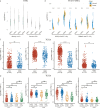

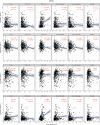


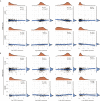

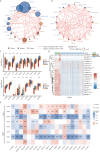
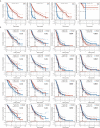
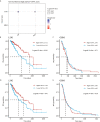




Similar articles
-
Mutational profiling of low-grade gliomas identifies prognosis and immunotherapy-related biomarkers and tumour immune microenvironment characteristics.J Cell Mol Med. 2021 Nov;25(21):10111-10125. doi: 10.1111/jcmm.16947. Epub 2021 Oct 1. J Cell Mol Med. 2021. PMID: 34597473 Free PMC article.
-
ARL3 is downregulated and acts as a prognostic biomarker in glioma.J Transl Med. 2019 Jun 24;17(1):210. doi: 10.1186/s12967-019-1914-3. J Transl Med. 2019. PMID: 31234870 Free PMC article.
-
MCM10 as a novel prognostic biomarker and its relevance to immune infiltration in gliomas.Technol Health Care. 2023;31(4):1301-1317. doi: 10.3233/THC-220576. Technol Health Care. 2023. PMID: 36872806
-
Identification of a novel cuproptosis-related gene signature and integrative analyses in patients with lower-grade gliomas.Front Immunol. 2022 Aug 15;13:933973. doi: 10.3389/fimmu.2022.933973. eCollection 2022. Front Immunol. 2022. PMID: 36045691 Free PMC article. Review.
-
Molecular subtypes based on PANoptosis-related genes and tumor microenvironment infiltration characteristics in lower-grade glioma.Funct Integr Genomics. 2023 Mar 17;23(2):84. doi: 10.1007/s10142-023-01003-5. Funct Integr Genomics. 2023. Retraction in: Funct Integr Genomics. 2024 May 11;24(3):88. doi: 10.1007/s10142-024-01374-3. PMID: 36930242 Retracted. Review.
Cited by
-
SOX13 as a potential prognostic biomarker linked to immune infiltration and ferroptosis inhibits the proliferation, migration, and metastasis of thyroid cancer cells.Front Immunol. 2024 Dec 11;15:1478395. doi: 10.3389/fimmu.2024.1478395. eCollection 2024. Front Immunol. 2024. PMID: 39726600 Free PMC article.
-
STEAP3 is a potential preliminary prognostic biomarker of glioblastoma.Sci Rep. 2024 Dec 28;14(1):30994. doi: 10.1038/s41598-024-82145-9. Sci Rep. 2024. PMID: 39730631 Free PMC article.
-
A novel inflammation-related signature for predicting prognosis and characterizing the tumor microenvironment in colorectal cancer.Aging (Albany NY). 2023 Apr 2;15(7):2554-2581. doi: 10.18632/aging.204630. Epub 2023 Apr 2. Aging (Albany NY). 2023. PMID: 37014331 Free PMC article.
-
Mutational profiling of low-grade gliomas identifies prognosis and immunotherapy-related biomarkers and tumour immune microenvironment characteristics.J Cell Mol Med. 2021 Nov;25(21):10111-10125. doi: 10.1111/jcmm.16947. Epub 2021 Oct 1. J Cell Mol Med. 2021. PMID: 34597473 Free PMC article.
-
TIGD1 Function as a Potential Cuproptosis Regulator Following a Novel Cuproptosis-Related Gene Risk Signature in Colorectal Cancer.Cancers (Basel). 2023 Apr 13;15(8):2286. doi: 10.3390/cancers15082286. Cancers (Basel). 2023. PMID: 37190215 Free PMC article.
References
-
- Hofer S, Roelcke U, Herrmann R. [New Aspects of Interdisciplinary Therapy for Malignant Gliomas in Adults]. Schweiz Med Wochenschr (1999) 129:1332–41. - PubMed
Publication types
MeSH terms
Substances
LinkOut - more resources
Full Text Sources
Other Literature Sources

